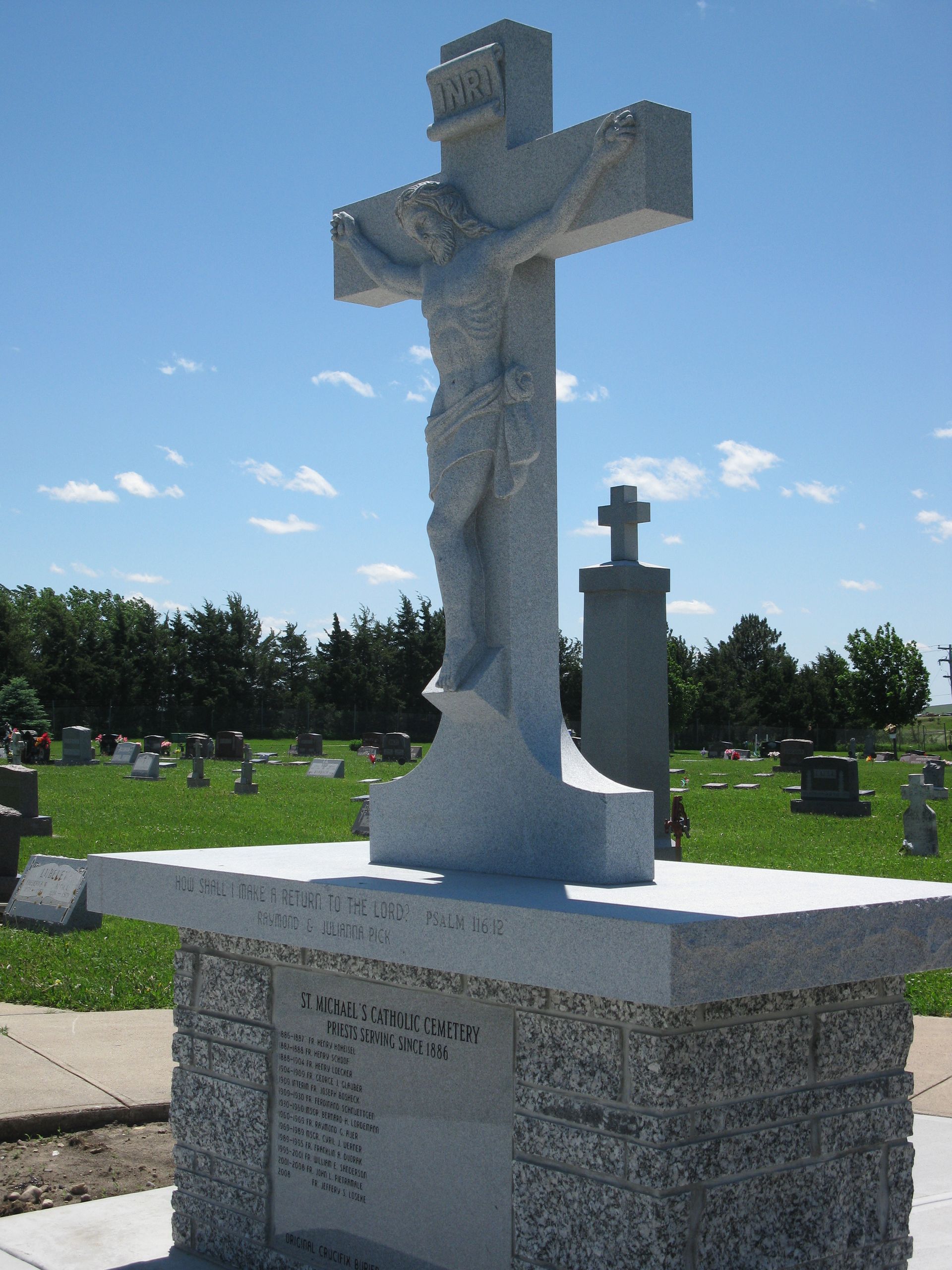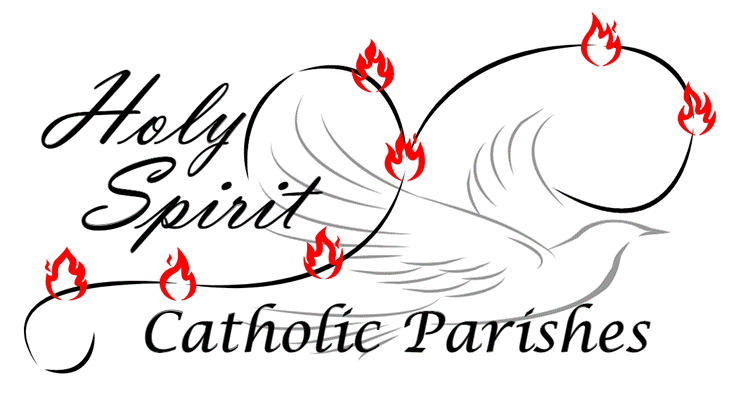St Michael Cemetery
Hartington
St. Michael Cemetery
St. Michael Cemetery is located at the corner of Highway 84 and Highway 57 on the southwest edge of Hartington.
After opening the map, you can bring up a search option by holding down the "Ctrl" key and press the "F". Search by name - name(s) will be highlighted in blue. Click the "+" towards the top the of page to zoom in on the map.
Learn more about how to search for burials using the Billiongraves website or download the app.
There you can see images of the gravestones. The Billiongraves records are GPS tagged so you can see where burials are in a cemetery using the app.
Purchasing Burial Plots
Contact: Holy Trinity Office 402-254-6559
Parishioners may purchase space for burials for themselves and for family members. Those who purchase space for burial are purchasing the right to interment in a specific plot. The physical land does not become the property of the purchaser; rather, it remains the property of the parish.
Payment in full is required at the time of death and must be made prior to burial. In other cases, a purchase agreement must be completed if payment is not in full at the time of purchase.
| Costs | Single Plot | Interment Fee |
|---|---|---|
| Parishoners | $250 | $125 |
| Non-Parishoners with Family Connection in Cemetery | $750 | $175 |
| Non-Parishoners without Family Connection in Cemetery | $750 | $175 |
St. Michael Cemetery Guidelines (Download)
- Decorum: The cemetery is a sacred space. A sense of reverence should be displayed at all times. Pets, food & drink, smoking, and the like are not permitted on cemetery grounds.
- Outside Receptacles: An outside receptacle is required for full-sized casket burials. The minimum requirement is a concrete liner for the grave. A concrete or steel vault is recommended.
- Headstone Markers: Headstone markers must be made of granite, marble, bronze, or other durable and dignified material and should be set upon a concrete or granite foundation. Markers should be permanently set within one year of burial. Individual markers should be no more than 48 inches wide. No monuments or other memorials, trees, plants, shrubs, or other embellishments of any kind may be placed upon the grave space.
- Marker Placement: Monument companies should first contact the cemetery’s caretaker beforehand in order to oversee the setting of all markers. Wintz Funeral home is presently marking all gravesites for monument placements and grave location. Holy Trinity Parish will not be responsible for damages unless negligence on the part of the parish can be proven.
- Burial of Cremains: Up to two cremation interments are allowed on a single grave space. An urn may be buried on top of a full-body burial vault but only with written permission of the owner of the grave space. This is required before the burial of the urn. Burial of infants or pre-born children is permitted on top of the remains of a full-body burial but only with the written permission of the owner of the grave space and only after the full-body interment.
- Footstone Markers: Footstone markers indicating a second burial in a grave space must be placed at the foot of the grave and be flush with the ground.
- Vases & Accessories: Permanent vases and other accessories should be placed no closer than six inches from the border of the adjacent space. All permanent or quasi-permanent accessories should be placed adjacent to the marker so as to facilitate mowing. Glass vases/objects are not allowed.
- Grass & Seeding: It is the responsibility of the family of the deceased to seed or sod grave space after interment.
- Decorations: Appropriate decorations may be placed on graves one week prior to a holiday and removed no later than three weeks after the holiday. After three weeks, items may be discarded without notice. Decorations contrary to the Catholic faith will be removed immediately and without notice. The parish will not be responsible for loss of or damage to personal property placed on cemetery property.
- Returns/Transfers: The owner of grave space may return it to the parish as a donation. The parish office must be contacted in order to effect a transfer of grave space to another owner for proof of transfer.
- Burial Records: For recordkeeping purposes, the parish office must be notified when an interment is to take place in the cemetery. Burial of non-Catholics is permitted if Catholic family members are buried in the cemetery.
- Disinterment:
Nebraska State law requires that a disinterment permit be obtained from the State prior to disinterment of remains. A licensed funeral director must be present for disinterment.
Cemetery Board
- Members
Cemetery History
On June 18, 1888, four acres of land was purchased from John J. and Susanna Lammers for $1.00. This ground is located southwest of the intersection of Highway 84 and Highway 57. In 1975, the Parish could see that more land was to going to be needed for burials. Paul & Theresa Kathol donated approximately one acre of land west of the oil road. In 1978, the Parish purchased a small amount of land from the Hartington Development Corporation to have more land on the west end.
The earliest burial recorded is Louisa Goetz. The headstone reads December 6, 1885. The grave is located in Block 21-Lot 7-Grave 6. There are approximately 20-25 burials per year at St. Michaels Cemetery.
It was typical for families to purchase a "family plot" in the 1900's. A "family plot" consisted of 6 grave sites. In the event of a family death, they would all be laid to rest in the same area of the cemetery. Childhood diseases, a high percentage of stillborn births, and mothers dying during childbirth were more common in the 1800 and 1900's. The purchase of the family plot was a way for families to prepare for their future. Over the years, many families were allowed to outline their plot with a cement foundation. This made it difficult to keep the overall cemetery level and really difficult to mow with power mowers. In the summer of 2010, the foundations were brought to the top of the ground and a group of volunteers hauled these chunks of cement away and filled in these gaps with good soil that was provided by Bob Heimes. At the same time the area was leveled before seeding it with grass. We are now able to keep the grounds looking groomed.
For many years, premature babies or babies who died without Baptism, were buried in the "Limbo Plot". This area was located on the southwest corner of the original cemetery ground. It is now marked with a stone for the unborn provided by the Knights of Columbus. In 1969, Msgr. Cyril Werner became Pastor of Holy Trinity and under his direction these babies were no longer placed in the Limbo plot, but instead buried on top of or at the foot of grandparents or relatives already buried in the Cemetery, marking their graves with small footstones. Some families chose to buy plots for these children and marked the graves with headstones.
Soon after Msgr. Werner came to Holy Trinity in 1969, he took it upon himself to Block and Lot the Cemetery. No history could be found as to when the original cement crucifix was placed in the center of the Cemetery. He set up the existing record system and platted the Cemetery, using the crucifix as the center point. With the help of Lisa (Steffen) Dendinger, a high school student at the time, Msgr. walked the Cemetery and recorded all of the information that was on the stones. The "old" part of the Cemetery consists of 48 Blocks. Each block has seven lots and there are six grave sites within each lot, for a total of 2,016 burial plots. Then when the additional ground was added in the 70's, 12 more Blocks were added. Each of these blocks contained 12 lots, with six grave sites in each lot, for an addition of 864 graves in the "new" section of the Cemetery. At the present time, our Cemetery has 2,880 grave sites.
The road entering from the north was a dirt road until additional land was purchased to the west. In 1981, Richard and Kathy Wintz donated the money to blacktop the road; this was a huge improvement for our Cemetery. Then in 2010, the children of Richard and Kathy Wintz donated the money to complete the road on the south end of Cemetery stretching to the east fence and turning north to the east steps. With this improvement, the burial plots became more accessible on the south end of the cemetery. Because of this new road, the land south of it will be made ready for additional grave sites in the future.
The sidewalks leading to the center cross were poured in 2000. This project was completed by a group of Parish volunteers and Hartington Concrete donated the concrete.
In 2004, the Louis Forinash Family donated some decorative trees along the new road. Then in 2006, Hartington Tree Service removed some older trees and replaced them with some flowering crab trees to improve the overall look of cemetery.

In 2010, a group of Parish men under the guidance of Fr. Jeffery Loseke, the present Pastor, met to assess the upkeep and improvements needed at the cemetery.
The tombstones needed attention and the cement crucifix needed to be replaced, as it was showing years of deterioration and cracking. In the summer of 2010, the core group called on many volunteers, including Kenny Hochstein and his family, to help reset the tombstones. Keith Fiscus helped to remove the old concrete plot borders. Many hours of labor were donated by the Parishioners to renovate the cemetery grounds. Ray & Juliana Pick donated the new marble crucifix and altar in November of 2010. They also donated the money for the restoration of the original staircase and handrails on the east side of the property, the new benches around the cross, and the repairs to the original fence. The original cross was buried beneath the new altar and cross, which was placed in the same location.
For many years the cemetery had a caretaker by the name of Louis Haberman. He mowed and took care of the cemetery. Louis dug and filled in the graves when needed. After Louis retired Msgr. Werner mowed the cemetery for some time until Ray Gubbels took over and mowed during the 1980's and 1990's. When Ray retired, Holy Trinity Parish developed mowing teams. In 2011, there are eleven teams with approximately 35 members on each team. The captain of the team calls members when it is time to mow and members are asked to show up with mowers and trimmers for an evening to mow the entire cemetery.
St. Michael's Cemetery would not be what it is today if it were not for the generosity of many volunteers and donators. We hope that future generations will continue to care for our final resting place, St. Michael's Catholic Cemetery.
(Holy Trinity Catholic Church, Hartington, Nebraska, 125 Years 1886-2011, p. 47-48.)
